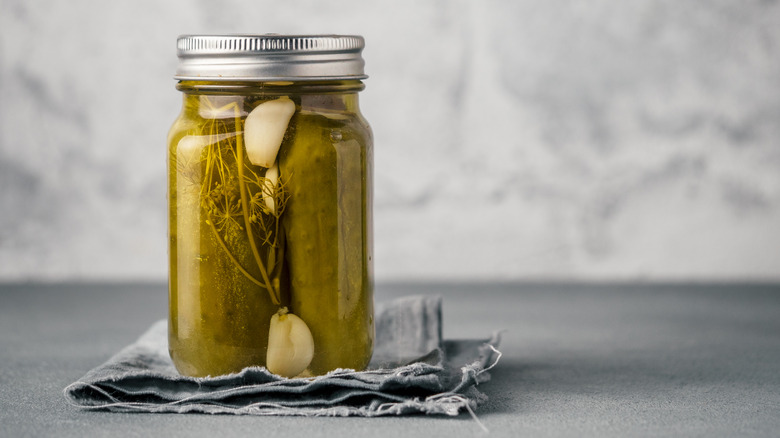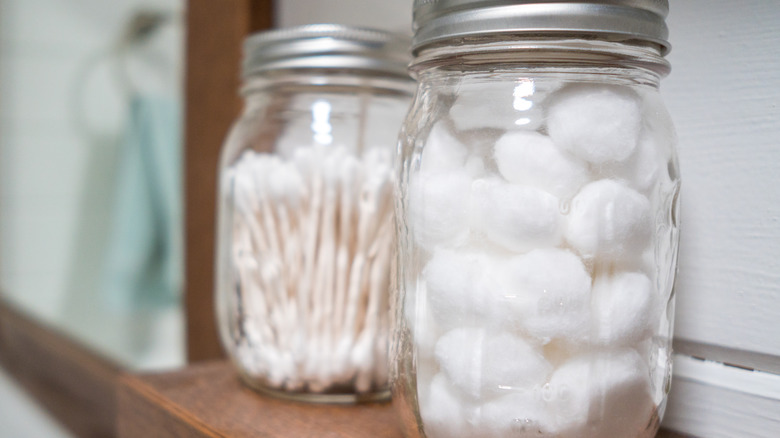Mason Jars Were Indeed Named After A Person
The Earl of Sandwich, Earl Tupper, and Ignacio Anaya "Nacho" Garciá all lent their names to their own food-related creations. The Mason jar, the canner's choice for more than 160 years, was also named after the person who invented it.
Prior to canning, food preservation relied on salting, smoking, pickling, and freezing. Fermenting, the use of sugar, and spicing food heavily were other techniques to avoid ever-present foodborne illnesses. Napoleon provided the impetus for canning when he offered a reward for devising a means of preserving food for his soldiers.
Nicolas François Appert, henceforth known as "The Father of Canning," answered the call. His canning method used jars plugged with a cork, boiled, and sealed with wax. It earned him the prize and, though imperfect, it remained the standard.
That is, until John Landis Mason (1832-1902), a tinsmith from Vineland, New Jersey, devised the jar that bears his name. His US Patent # 22,186 revolutionized the canning process and modernized the industry. Today, 17 Mason jars per second are churned out by Ball Canning, according to Mason Jar Lifestyle.
Unfortunately, per Find A Grave, the hapless inventor died destitute and failed to reap the rewards of his genius. Through a combination of bad luck and greedy competitors, Mason was barely able to support himself and his children.
Mason's series of patents
Mason set out to upgrade canning by devising a lid that created an air-tight and waterproof seal as it was tightened, according to Mason Jars. He achieved his goal with a series of inventions, culminating in the November 30, 1858 patent "Improvement in Screw-Neck Bottles."
Mason manufactured a glass bottle with a zinc screw cap that could be hermetically sealed by matching the lid's threads with those of the bottle. He improved on his invention by adding a rubber washer to the cap and eventually altering the side of it to make it easier to grip and open.
Mason's jars were made using bleached glass that was transparent. The innovation allowed the user to inspect the contents for spoilage, the Huffington Post reported. Today's Mason jars are typically made from soda-lime glass.
Regulations allowed his designs to enter the public domain after 20 years, and competitors swooped in after 1879. The Ball Corporation licensed the Mason jar, and became a main manufacturer until the 1990s. Newell Brands is now the primary provider of Mason jars in North America.
Still in use today 160 years later
The brainy inventor also is credited with the first screw-top salt shaker and pepper shaker. Mason's jar even inspired the first canning cookbook in 1887, Sarah Tyson Rorer's Canning and Preserving.
Besides canning, a Mason jar is used in Starbucks to serve their cold brew. They are also the go-to drinking vessel in some country-style restaurants or home kitchens. They can double as pen and pencil holders or trendy cocktail glasses. A detailed Web book has even been published: "The Mason Jar: Preserving 160 Years of History."
Jars of various vintages or manufacturers are coveted by collectors, and have been sold for hundreds, even thousands, of dollars. According to the New York Times, a cobalt blue Mason jar is the Holy Grail, worth up to $15,000 in the collectors' market, as of 2012. Country Living claims that if all the Mason jars sold in a year were lined up, they would span the globe.
John Landis Mason's contributions to canning made it safer and more affordable, and allowed city folk greater access to fresh food. The basic design of his brainchild has hardly changed since its inception. Although the inventor lost out on most of the monetary rewards, he would be pleased that November 30, the date of his pivotal Mason jar patent, has been designated National Mason Jar Day.


